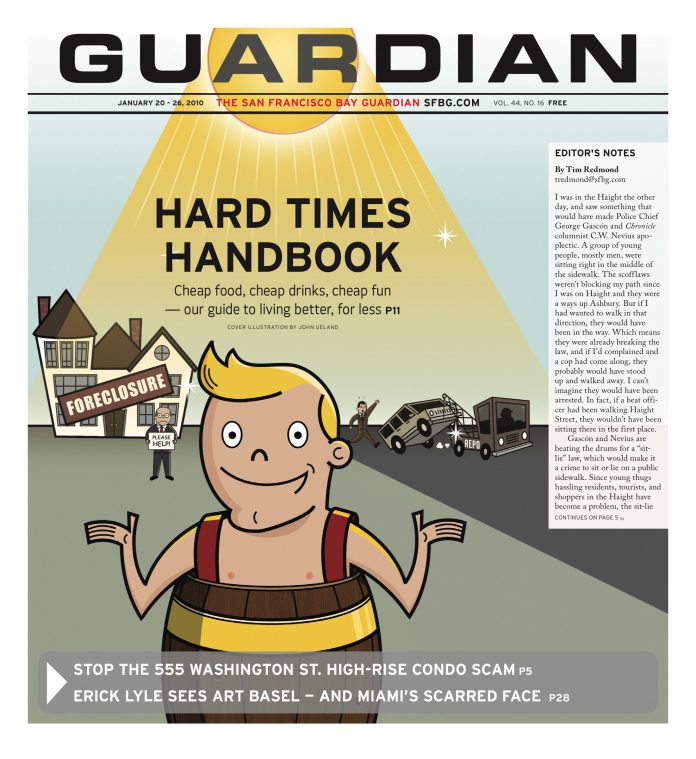The San Francisco Planning Commission and Recreation and Park Commission will hold a special joint meeting Jan. 21 to decide whether to allow the owner of the Transamerica Building to construct a 400-foot condo tower next door that would violate so many elements of the city’s Planning Code and rational planning policy that it’s almost impossible to list them all.
The building, which would contain 248 luxury housing units — something the city doesn’t need — would cast shadows on two city parks, make downtown traffic and air quality much worse (thanks to a four-level underground parking garage), and require special spot zoning to double the allowable height from 200 feet to 400 feet.
There is no conceivable policy reason to approve this abomination. Even so, Mayor Newsom’s Planning Department is pushing it, and four of the seven planning commissioners are Newsom appointees. If the mayor’s staff and appointees allow this project to go forward, it will be a lasting legacy of shame for his administration.
Aegon Corp. wants to build housing next to its landmark property, and nothing in the Planning Code discourages that. In fact, city planners are pushing for more housing downtown, close to workplaces. In theory, that should cut down on transportation needs and car use. And of course, just about everyone in town believes that San Francisco needs more housing.
In practice, the program hasn’t worked out. The new housing units built in downtown San Francisco have been purchased to a large extent by commuters who travel to Silicon Valley, by retirees who aren’t working anyway, by wealthy people who want a pied-à-terre in San Francisco and by real-estate speculators looking for a quick buck.
The high-end condos haven’t done anything to relieve pressure on the housing market and don’t meet the city’s urgent need for more housing for middle-class and low-income families. If anything, the luxury condo market downtown is overbuilt right now.
Still, if Aegon wanted to build a 200-foot tower within existing zoning parameters, the company could probably get away with it.
But that’s now what’s on the table. The 555 Washington St. building would be double the allowable height — and would violate Proposition K, the 1984 law that bars the construction of towers casting shadows on public parks. City planners acknowledge that both Sue Bierman Plaza and Maritime Park would lose sunshine if the high-rise is built.
In exchange, the developer has offered to give the city a new park. But that proposal is a scam, too. There’s already open space on the site — Redwood Park. That’s considered private property, to be used by Transamerica Building residents — but it exists only because the city mandated it in 1971 as part of the trade-off for constructing the Pyramid, which violated city height and bulk rules at the time.
The new park would include an additional 4,000 square feet, but also requires that the city sell Aegon part of a city street, Mark Twain Alley. Aegon will then use the air rights above that street to increase the bulk of the building, and construct a parking garage below.
So the city gives up public property to gain a slight addition to a park that the city forced the developer to construct in the first place — and in exchange lets the developer block the sun on two existing parks. This is considered a fair tradeoff?
In the wake of the construction of the Pyramid, the city adopted zoning rules that drove high-rises south of Market Street and imposed straight height limits on the edge of Chinatown and North Beach. The 555 Washington project would be a major, precedent-setting step backward.
And what’s the endgame here? What does the city get for bestowing a developer with a huge basket of favors? An unattractive building that will offer housing for a small number of very rich people.
The Planning Commission and Rec-Park Commission must both sign off on any proposal that casts shadows on a park. And while planning staffers have come up with some remarkably convoluted arguments (there weren’t good computer programs in 1984, and now we can track the sun better so it’s okay to rewrite the rules to allow more shade), the sunlight issue alone ought to derail this building. But there’s so much wrong with the proposal that any one of half-dozen issues should be enough to ensure that it never gets beyond the drawing board.
Thursday’s vote will be a test for Newsom and his commissioners. If they allow 555 Washington to proceed, it will be a sign that city planning is entirely in the hands of private developers and that any sense of reason has been lost in the process.

